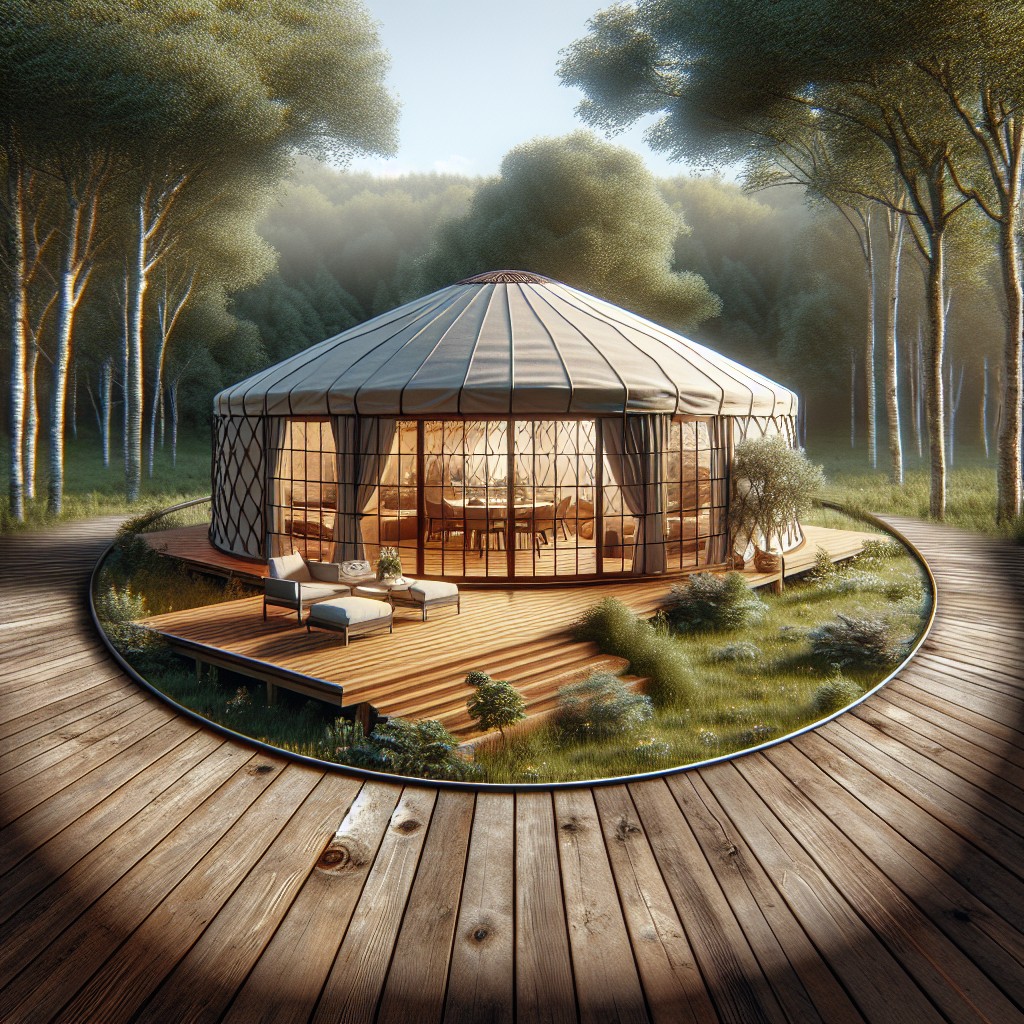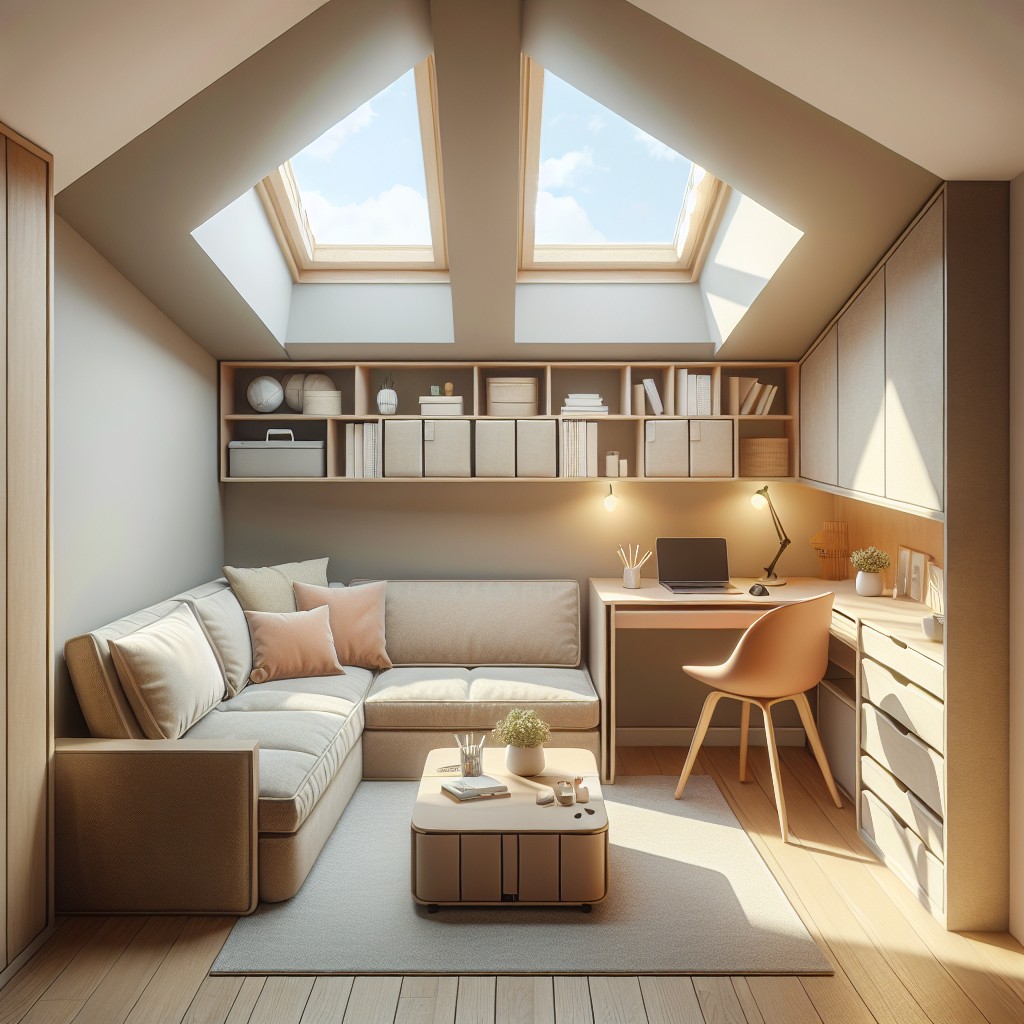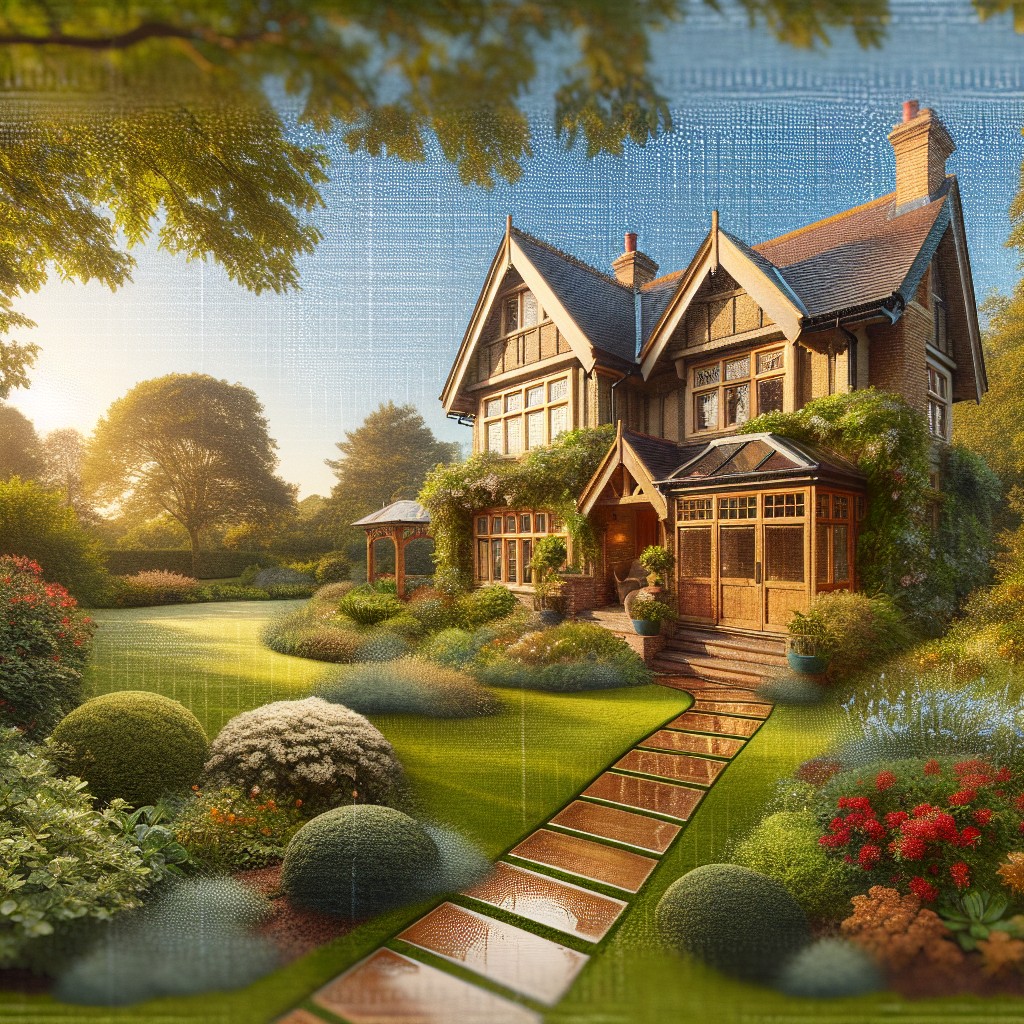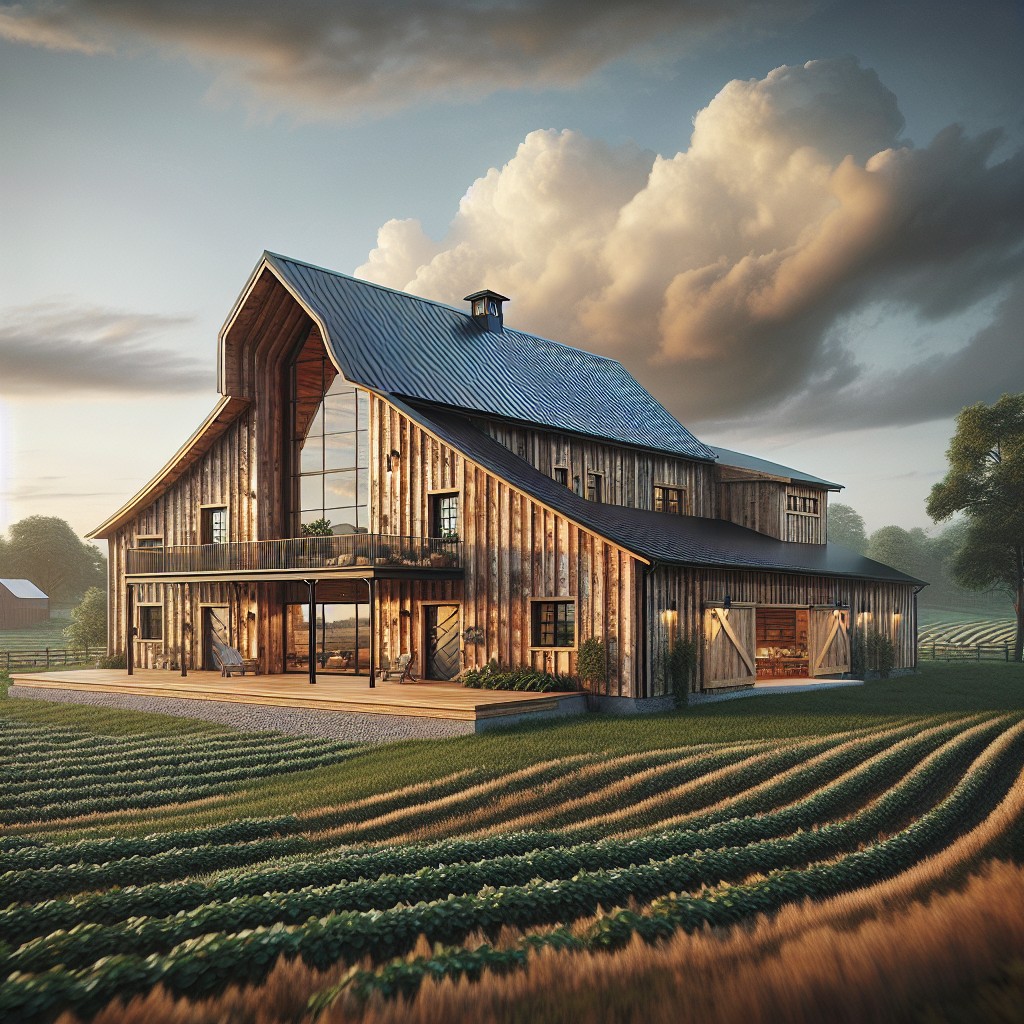Last updated on
Explore these creative cabin loft ideas because they perfectly blend sustainability with modern, cozy aesthetics for that ideal retreat.
I have created these unique designs for your inspiration. I hope you will enjoy them!
Venturing into the world of cabin loft designs can be a mesmerizing endeavor. Often, the same designs seem to reappear, making the exploration a bit monotonous. This article, however, aims to throw light on some fresh and unique loft ideas for your cabin.
With a slant towards sustainable architecture, these ideas are bound to lend a distinctive charm to your otherwise conventional cabin. While we will provide resources for some of the best existing designs at the end, the main focus is to introduce you to novel perspectives that you may find both intriguing and helpful.
So, get set to transcend the usual and step into the realm of extraordinary loft design ideas for your cabin!
Circular Staircase for Cabin Loft
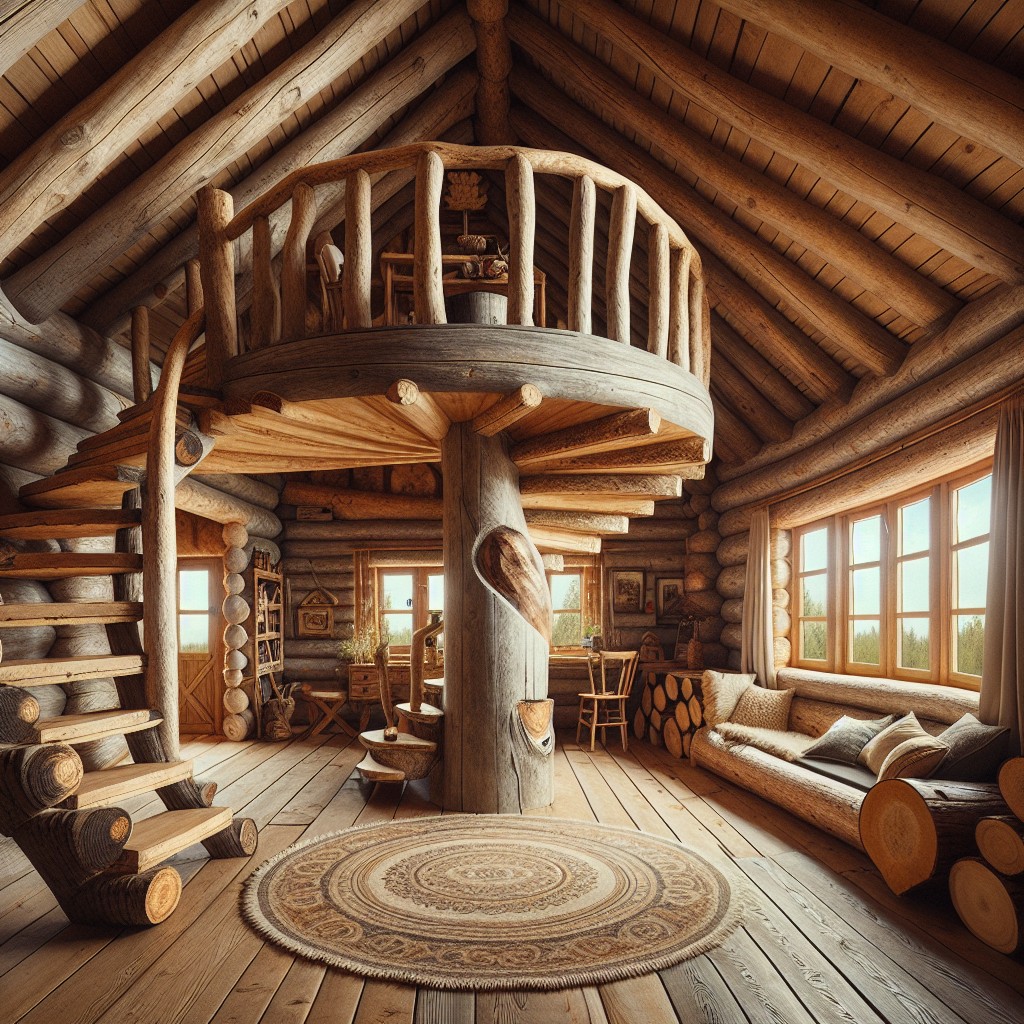
Opting for a circular staircase in your cabin loft is not only a space-saver but also a standout design feature that can enhance the overall aesthetic. When choosing a circular staircase:
- Measure Accurately: Ensure you have the precise height and diameter for the staircase to fit comfortably in your cabin without overwhelming the space.
- Select Appropriate Materials: Wood complements the rustic cabin feel, while metal can add a modern twist. The choice of materials can have a significant effect on the cabin’s ambiance.
- Safety First: Include sturdy handrails and ensure treads are wide enough for safe footing, especially in a cabin where users might not be accustomed to the layout.
- Customization: Tailor the design to reflect your style – whether that’s through ornate balusters, unique tread designs, or integrated lighting for a warm glow.
- Accessibility Considerations: While chic, remember that circular staircases may not be suitable for everyone. Consider the needs of all potential users, including pets or those with mobility issues.
Incorporating these elements will create not just a functional ascent to your loft but a central feature that is both practical and appealing.
Adding Room Partitions to Your Loft

Room partitions can transform an open loft space into distinct functional areas without compromising the airy feel of the cabin. Consider these options for delineating space:
- Sliding panels: Choose lightweight materials that glide easily for flexible separation when needed.
- Freestanding bookshelves: These can act as dividers while providing storage and display space.
- Curtains: A soft partition option that can be pulled back to open up the space, or closed for privacy.
- Foldable screens: They offer a portable and stylish way to break up the room.
- Glass partitions: Maintain an open feel while creating sound barriers between zones.
- Plant walls: Use tall plants to introduce a natural element and subtle division.
- Half walls: Build a partial wall to separate spaces while keeping sightlines open.
When incorporating room partitions, consider the overall flow of the space, the need for natural light in each partitioned area, and how permanent or flexible you want the divisions to be.
Eco-Friendly Loft Insulation Options
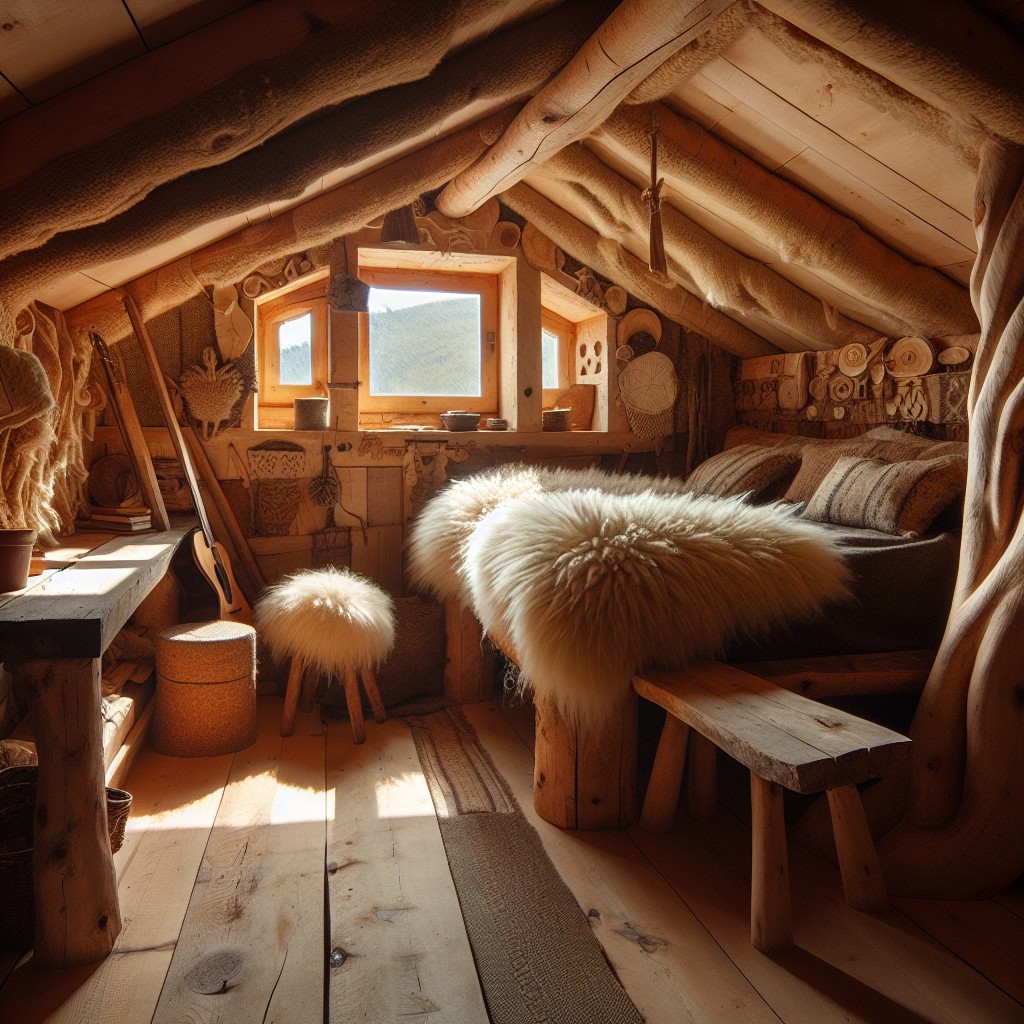
Insulating your cabin loft is crucial for energy conservation and maintaining a comfortable indoor climate. Thankfully, there are several eco-friendly options that not only keep your space cozy but also minimize environmental impact.
Cellulose, made from recycled paper that’s treated for fire resistance, is one of the most eco-conscious choices available. It’s blown into spaces, making it ideal for irregular areas and around obstructions.
Sheep’s wool is another sustainable insulator, with excellent thermal properties and moisture control. Its natural fibers are renewable and biodegradable, offering a low-impact solution.
Recycled denim, composed of post-consumer jean fabric, is a safe, non-toxic option that retains heat effectively without releasing harmful substances into your home.
Cork panels can be used for insulation as well. Harvested from the renewable bark of cork trees without harming the tree itself, cork provides excellent thermal and acoustic insulation.
Finally, rigid foam boards made from plant-based materials offer a high insulation value while being kind to the planet. These biodegradable panels are often produced with low embodied energy, meaning they require less energy to manufacture.
Selecting any of these materials ensures your cabin loft is insulated in an environmentally friendly way, cutting down on energy use while providing a safe, toxin-free living space.
The Art of Minimalist Cabin Loft Design

Understanding the minimalist ethos is key in creating an uncluttered and serene cabin loft. Embrace simplicity through the selection of functional furniture that doubles as storage to maintain a streamlined look. Prioritize quality over quantity; invest in well-crafted pieces that stand the test of time and avoid excessive decor.
Opt for a neutral color palette that reflects light and enhances the sense of space. Pops of color can be introduced through a single accent wall or decorative elements that can easily be changed out, allowing for flexibility in design.
Incorporate natural materials like wood, stone, and textiles to add warmth without overcomplicating the aesthetic. Consider open shelving to organize and display essential items neatly, keeping surfaces clean and clutter-free.
Maximize natural light by using sheer window treatments or leaving windows bare, connecting the indoor space with the surrounding environment. Strategically placed mirrors can also help in creating an airy and expansive feel.
Always look for ways to conceal belongings, such as under-bed storage or multi-functional furniture pieces. Remember, less is more when it comes to accessorizing; select a few meaningful items that speak to the cabin’s locale or personal memories.
Incorporating built-ins where possible not only saves space but also contributes to a cohesive look. Lastly, remember to leave some areas empty; negative space is a design element that provides visual rest and balance within a minimalist cabin loft.
Incorporating Nature in Your Loft Design
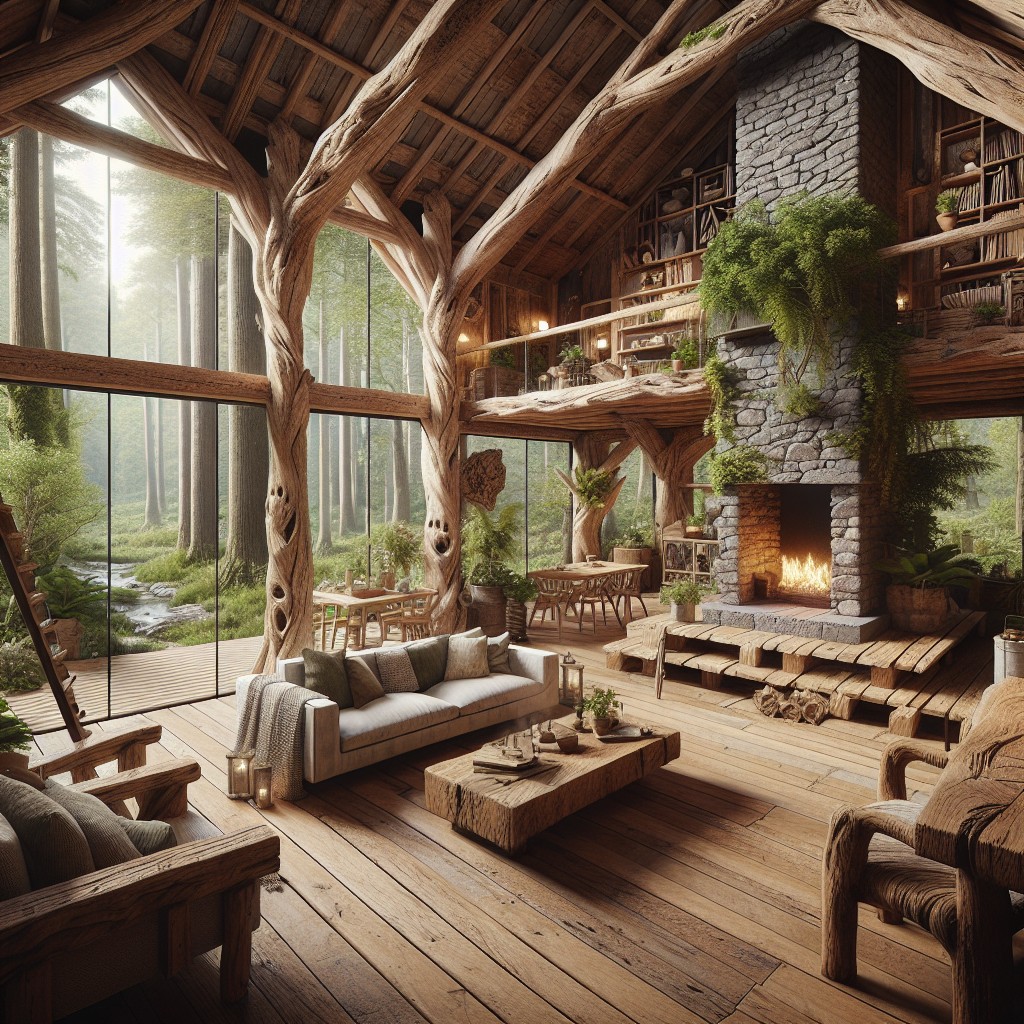
Merging indoor spaces with the natural world enhances the tranquility and aesthetic appeal of cabin lofts. Achieve this seamless blend by using a palette of earth tones for walls and fabrics, complementing the outdoor surroundings.
Install large windows or even a full glass wall to draw in natural light and frame picturesque landscapes, effectively bringing the outside in. Opt for sustainable, raw materials like reclaimed wood for flooring, beams, or furniture, resonating with the rustic outdoors.
Decorate with indoor plants or a vertical garden to purify the air and add a touch of greenery that is both visually pleasing and mentally calming. Consider a water feature, like a small indoor fountain, to incorporate a soothing auditory element that mimics the serene sounds of a forest or stream.
Hidden Storage Space in Your Cabin Loft
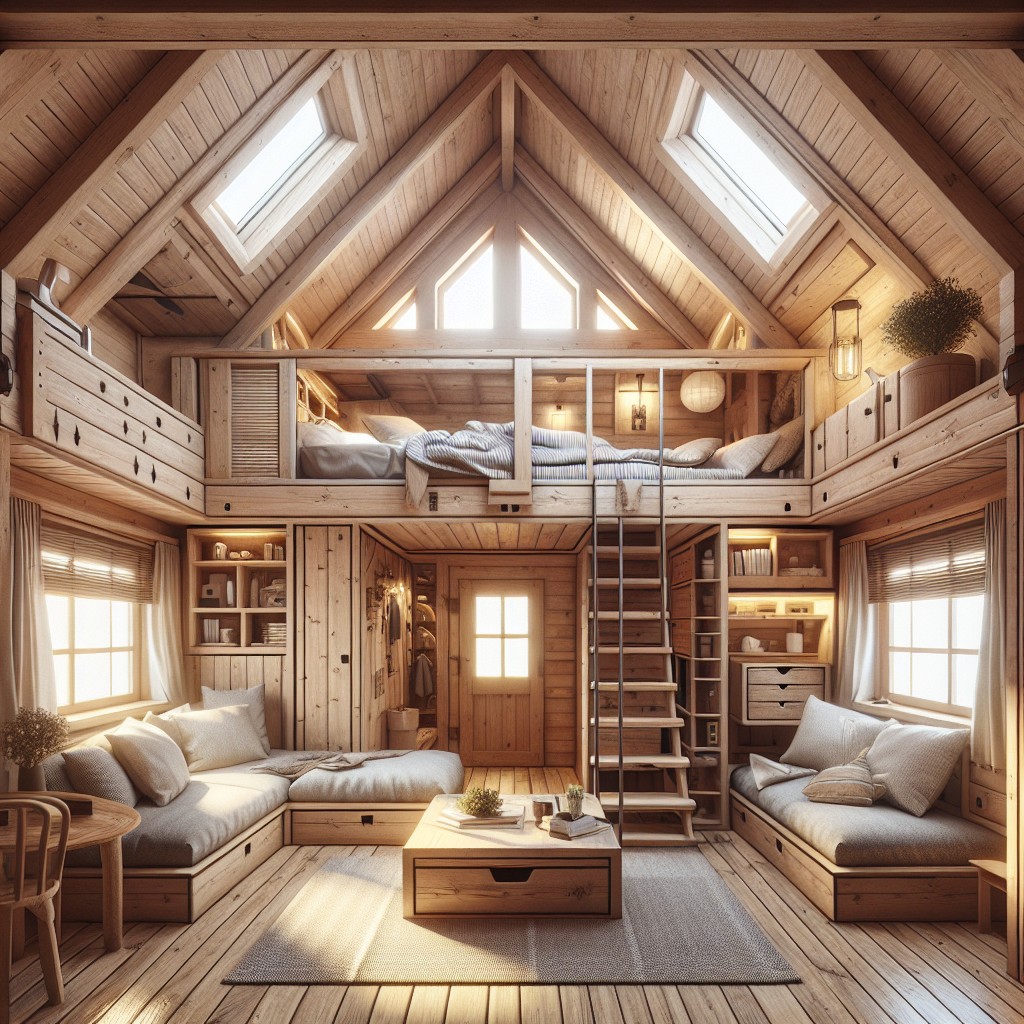
Maximizing every square inch is crucial in a cabin loft, which often comes with a smaller footprint than a traditional home. Ingenious storage solutions can help de-clutter the space and maintain an organized atmosphere.
- Built-in drawers can be integrated beneath the staircase leading to the loft, providing a space-saving place to stow away items.
- Consider adding a lift-up bed frame where infrequently used items can be stored out of sight but still within easy reach.
- Utilize the vertical space by installing floating shelves along the walls, which don’t take up floor area and can be used to display or store various objects.
- Custom cabinetry that fits into irregular nooks and crannies can take advantage of every potential storage space in the loft.
- Benches and ottomans with hidden compartments offer dual-purpose furnishings, presenting both seating and storage.
- Sliding panels or curtains can conceal storage areas, effectively blending them into the walls for a seamless look.
These solutions not only provide storage but also contribute to maintaining the aesthetic appeal of your cabin loft, ensuring a tidy and stylish space.
Loft Windows for Spectacular Views
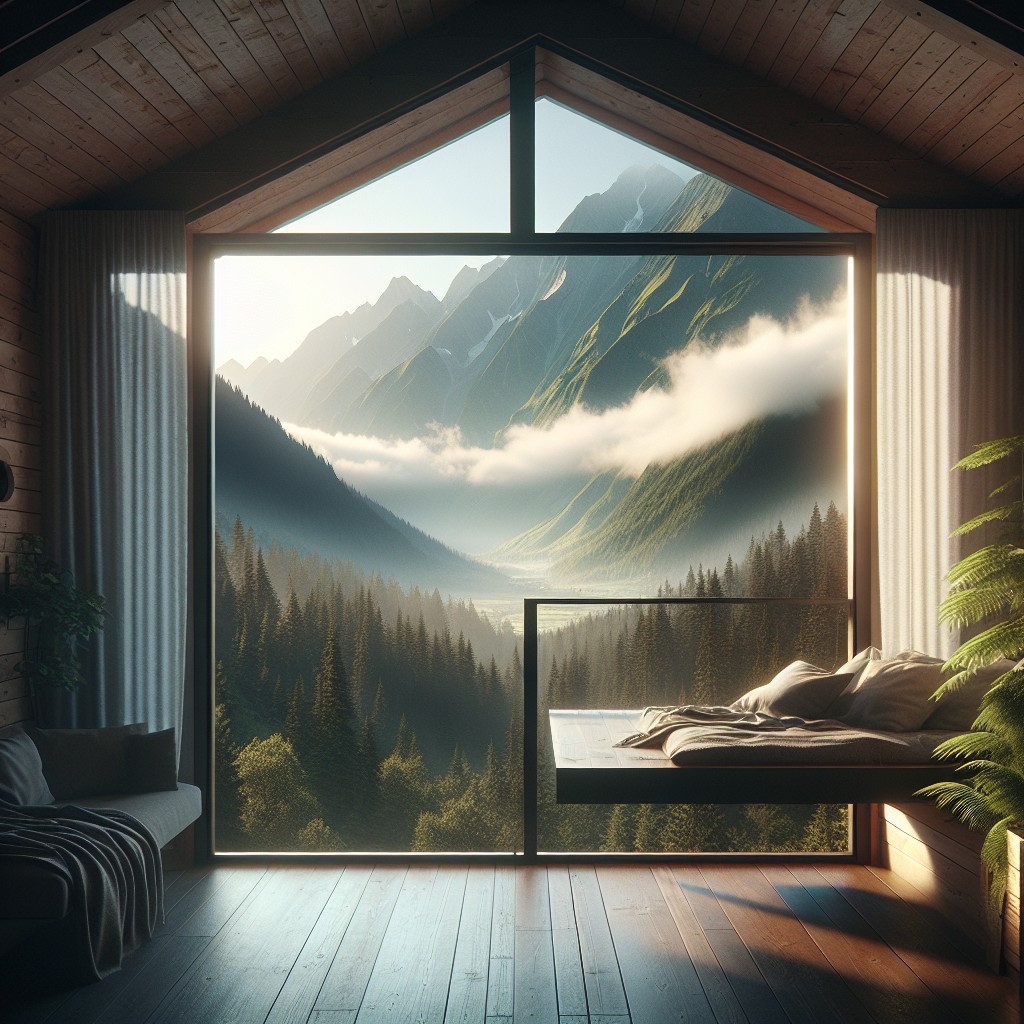
Selecting the right windows can transform your cabin loft from a simple space to an immersive natural retreat.
Large picture windows are perfect for framing expansive vistas, allowing you to enjoy the beauty of your surroundings without leaving the comfort of your loft.
Consider orientation – a south-facing window captures sunlight throughout the day, while east or west-facing windows offer stunning sunrise or sunset views.
For ventilation and added charm, skylights or dormer windows not only bring in more natural light but also provide an opportunity to gaze at the stars from your loft bed.
Remember to choose energy-efficient glazing to keep your loft comfortable year-round and integrate seamlessly with the cabin’s aesthetic for a harmonious look.
Rustic Cabin Loft Decor Inspiration
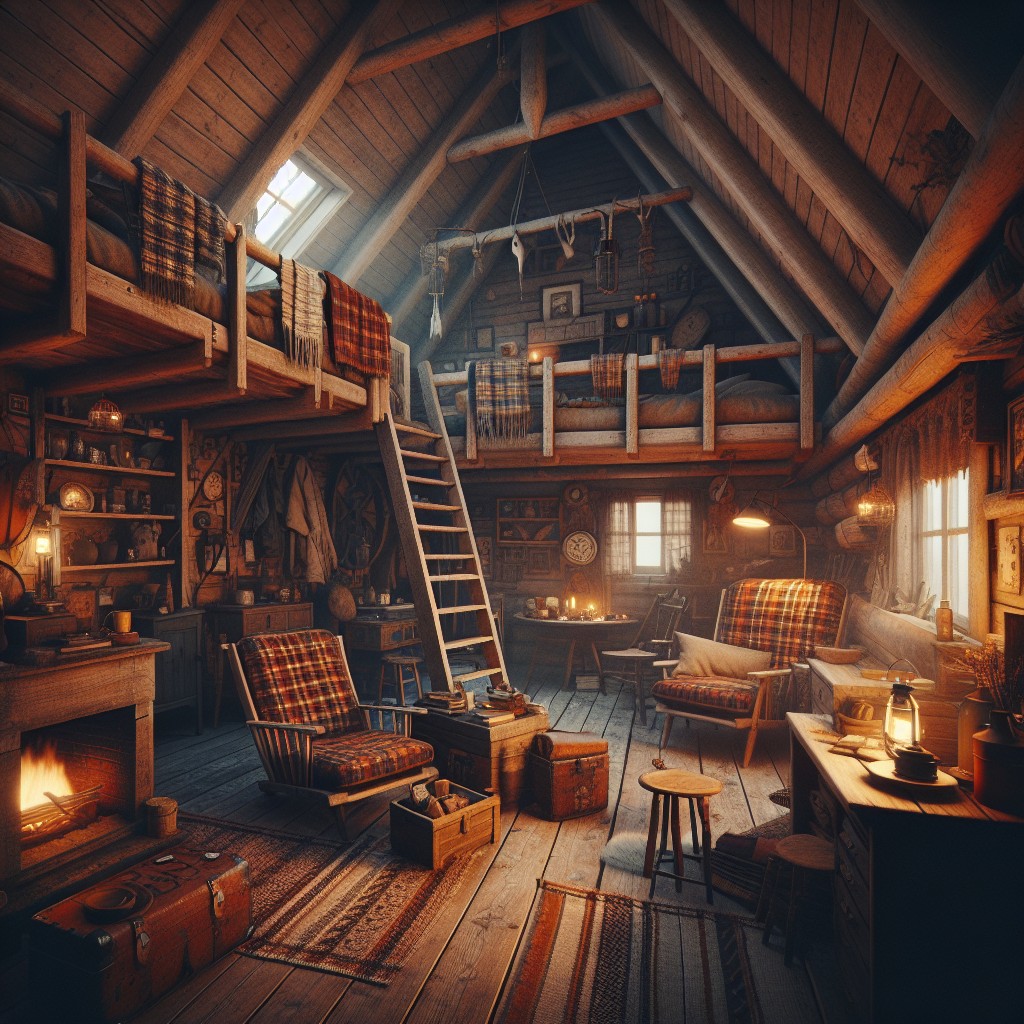
Embrace natural materials to establish an authentic rustic look within your loft. Utilize wood with a weathered finish for paneling, flooring, or furniture to add warmth and texture. Include a stone feature, such as a fireplace or accent wall, to bring a touch of the rugged outdoors inside.
Select furnishings that combine functionality with a handcrafted aesthetic. Opt for items made from reclaimed timber or antiques sourced from local flea markets to lend a sense of history and uniqueness to your space.
Use textiles that evoke a cozy, lived-in feel. Think woolen throws, plaid patterns, and handmade quilts that provide both comfort and visual interest.
Incorporate decor that reflects a cabin lifestyle; vintage outdoor gear, such as old fishing rods or snowshoes, can double as wall art. Lanterns, wrought iron fixtures, and pottery also enhance the rustic vibe.
Balance the raw with the refined by including elements with a touch of elegance like a chandelier made from antlers or a polished wood slab countertop, to ensure the space feels curated rather than cluttered.
Consider the lighting carefully to maintain an inviting atmosphere. Soft, ambient light from table lamps with rustic shades or wall sconces can mimic the glow of a campfire and provide warm illumination during the evenings.
Keep colors earthy and subdued to stick with the rustic theme—greens, browns, and grays are ideal choices that will make your cabin loft feel serene and connected to nature.
Cozy Reading Nooks in Your Cabin Loft
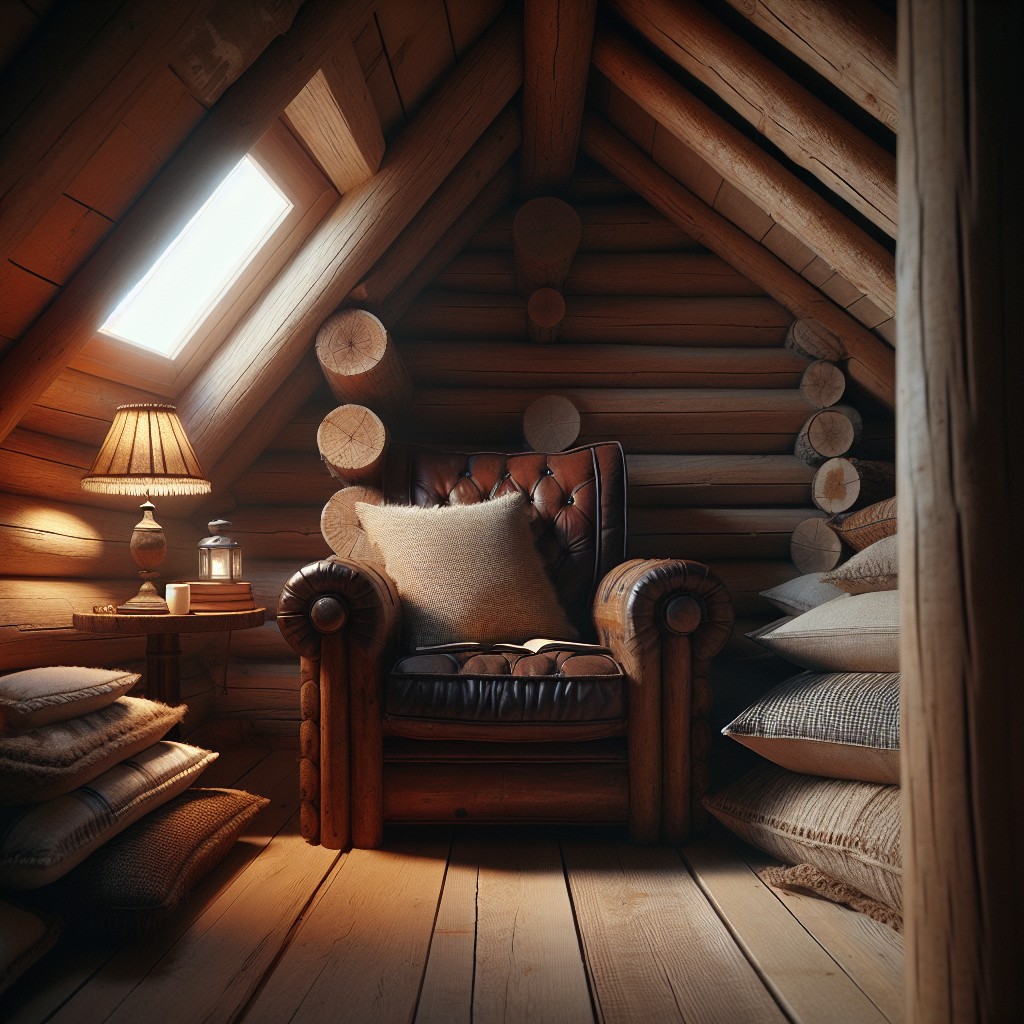
Creating a snug corner for reading in your cabin loft is both functional and charming.
Begin by choosing a spot near a window to take advantage of natural light and serene views.
A comfortable armchair with plush cushions makes for an inviting space to delve into a good book.
Consider a small side table to hold a hot beverage or your current read, alongside a floor lamp to ensure adequate lighting during the evenings.
For added privacy and a whimsical touch, hang flowing curtains or a canopy around your nook.
Build in shelves within arm’s reach to keep your favorite literature easily accessible.
Throw in a soft rug underfoot to warm up the space and add texture.
Don’t forget a cozy blanket to wrap around yourself as you read.
With attention to lighting, seating, and personal touches, your reading nook becomes a delightful escape within the broader haven of your cabin loft.
Safety Measures for Kids in Cabin Lofts
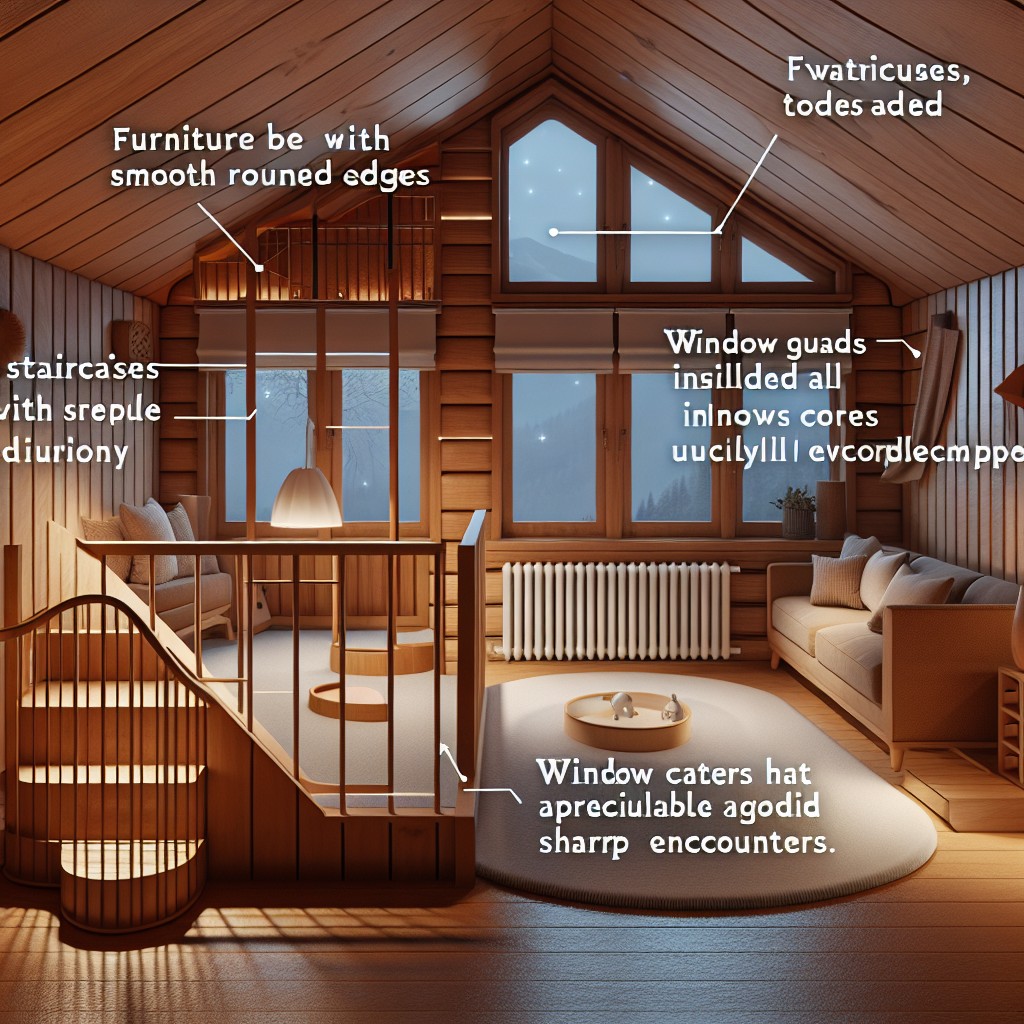
When accommodating young ones in a cabin loft, prioritizing their safety is essential. Incorporate sturdy railings at an appropriate height around the loft’s perimeter to prevent falls.
Railings should be designed with limited gaps to ensure that small bodies can’t slip through. Additionally, the access point, whether a ladder or stairs, needs to accommodate small feet securely. Opt for steps with railings or handholds on both sides for a safe ascent and descent.
For extra precaution, install safety gates at the top and bottom of the staircase, especially for toddlers prone to wandering. Use furniture arrangements to create a buffer zone away from the loft’s edge. Soft floor coverings, like rugs or interlocking foam tiles, can provide added cushioning against falls.
Lastlly, ensure that the loft is free from potential hazards such as dangling cords from blinds or curtains that present a strangulation risk. Regularly inspect the space for any loose fastenings or sharp edges to keep the environment secure and kid-friendly.
Building A Balcony Inside Your Loft
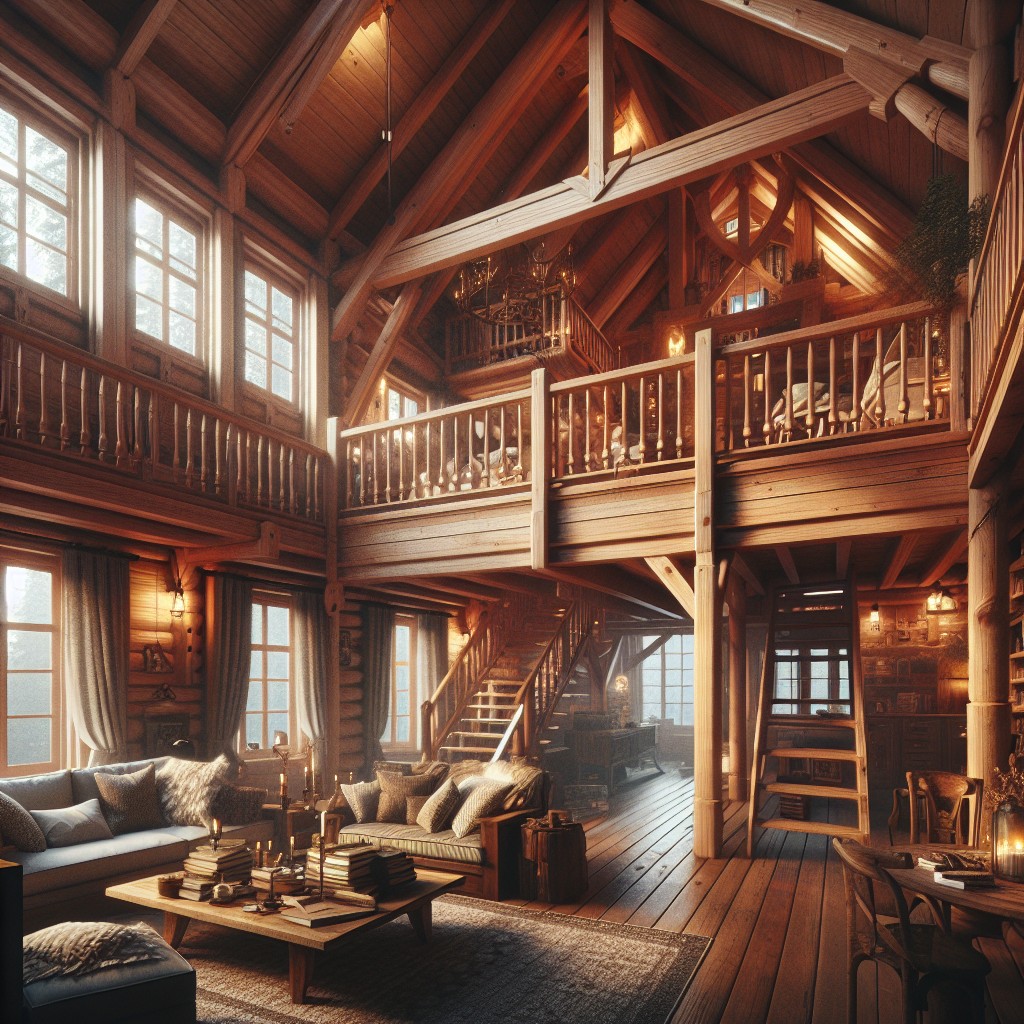
Integrating an internal balcony adds both charm and function to your cabin loft, creating an area where you can enjoy the openness of your space while maintaining a sense of privacy. Here are several points to consider when incorporating this feature:
- Support and Structure: Consult a structural engineer to ensure the mezzanine can support the addition without compromising the cabin’s integrity.
- Design Consistency: Use materials and design elements that complement the existing interior, maintaining a cohesive look with the rest of your cabin.
- Railings: Choose railings that provide safety without obstructing views. Glass or cable systems can be ideal choices.
- Access: Plan a safe and convenient access point. Ladder-like stairs or a minimalist staircase can conserve space.
- Purpose and Furnishing: Decide on the primary use of your internal balcony. If it’s for relaxation, consider space-saving furniture like fold-down tables or hammocks.
- Natural Light: Ensure the balcony placement maximizes natural light to the space below without creating unwanted glare.
- Outdoor Connection: To enhance the outdoor feel, consider adding elements like planters or a small water feature.
Implementing these points will help you create a balcony that’s not only an aesthetic asset but also a functional addition to your cabin loft.
Spiral Staircase to Maximize Space in Your Loft
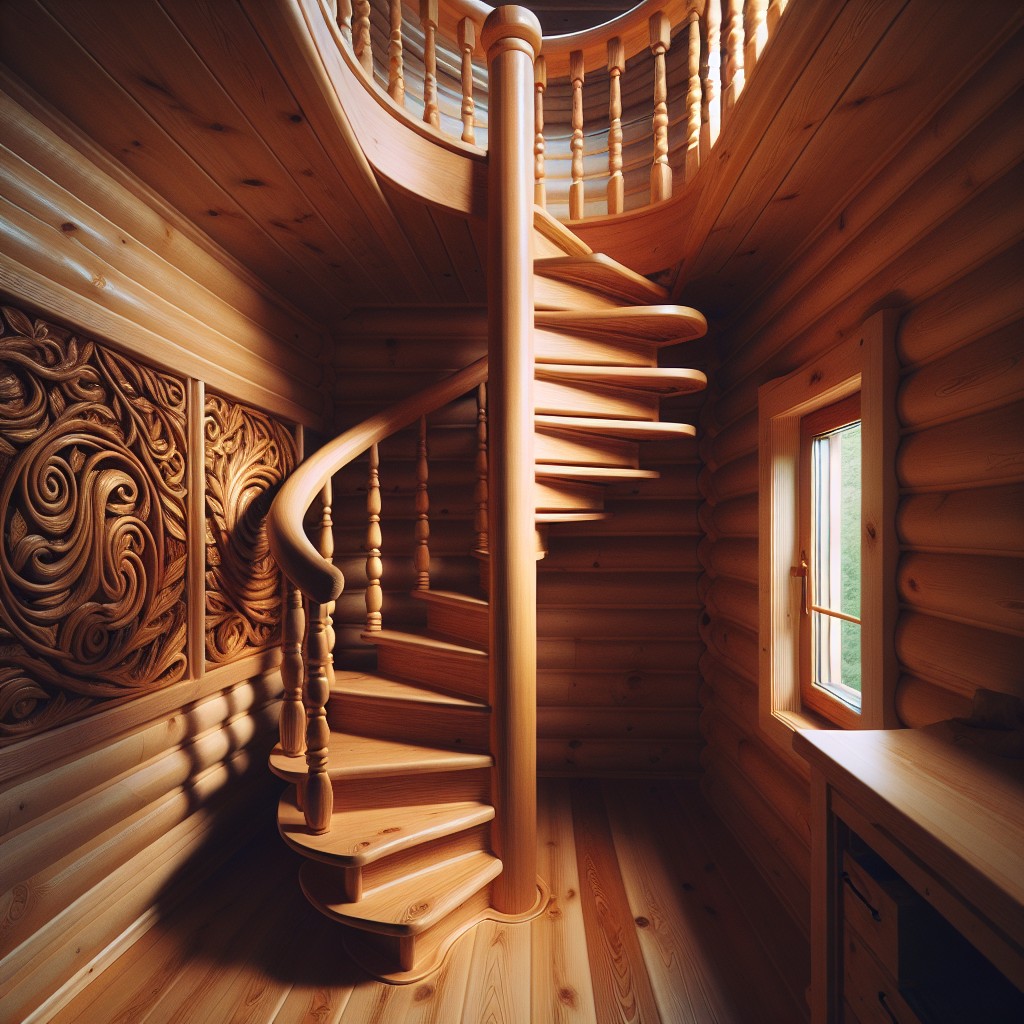
Opting for a spiral staircase can be a game-changer in terms of space efficiency and visual appeal within a compact cabin loft. These vertically inclined structures occupy less square footage compared to traditional staircases, freeing up valuable area for other uses. Their sleek, curved design can serve as an eye-catching centerpiece, enhancing the aesthetic of your loft space.
- Spiral staircases provide an economical use of floor space, perfect for small or narrow cabin lofts where every inch counts.
- The central pole design minimizes the footprint, leaving more room for furniture or movement.
- These staircases can be crafted from various materials, such as wood for a warm, rustic feel, or metal for a modern, industrial look, allowing them to blend seamlessly with your cabin’s interior design.
- Given their compact nature, spiral staircases can often be retrofitted into existing spaces with minimal structural changes required.
- They also add a layer of safety by providing a sturdy handrail that encircles the user as they ascend or descend.
- Their vertical ascent can be strategically placed to provide access to even the most awkwardly positioned lofts, maximizing the functionality of your living space.
Incorporating Greenery in Your Cabin Loft

Plants can transform a cabin loft into a serene retreat, infusing the space with vitality and a touch of nature. Consider these tips to seamlessly blend greenery into your loft:
- Vertical Gardens: Utilize vertical space by installing a living wall. This not only acts as a natural air purifier but also serves as a stunning focal point.
- Hanging Planters: Compensate for limited floor space with hanging planters. Opt for cascading varieties like pothos or ferns to add visual interest and a sense of height.
- Container Gardening: Integrate small trees or large plants in containers that complement the loft’s rustic elements. Citrus trees or fiddle leaf figs are attractive options that also thrive indoors.
- Herb Boxes: If your loft features a kitchen, herb boxes on the windowsill offer fresh flavors at your fingertips and increase the space’s functionality.
- Low Maintenance Selections: Choose plants like succulents or snake plants that require minimal care, especially if you’re often away from your cabin.
- Skylights and Windows: Position your plants strategically near natural light sources to ensure they receive ample sunlight without obstructing your view.
- Seasonal Touches: Rotate seasonal blooms or decorative branches to keep the decor dynamic throughout the year, celebrating the outdoors’ shifting beauty.
Incorporating these elements not only enhances the aesthetic appeal but also contributes to the overall well-being by promoting cleaner air and a calming atmosphere.
Space Saving Furniture Ideas for Small Cabin Lofts

Maximizing usable space in a small cabin loft requires furniture that is as functional as it is stylish. Foldaway beds and Murphy beds are perfect for transforming sleeping areas into daytime living spaces quickly.
Consider a convertible sofa that can become a guest bed or an ottoman that doubles as extra seating and storage. Nesting tables are versatile, offering additional surface area when needed but tucking away neatly. Wall-mounted desks and drop-leaf tables serve as workspaces or dining areas without consuming floor space.
Built-in shelving utilizes vertical areas for storage, keeping the floor clear. And don’t overlook the potential of corner furniture – it fits snugly into often underutilized spaces. By selecting pieces that can serve multiple purposes, your cabin loft will feel more expansive and organized.
Using Sky Lights to Brighten Your Cabin Loft
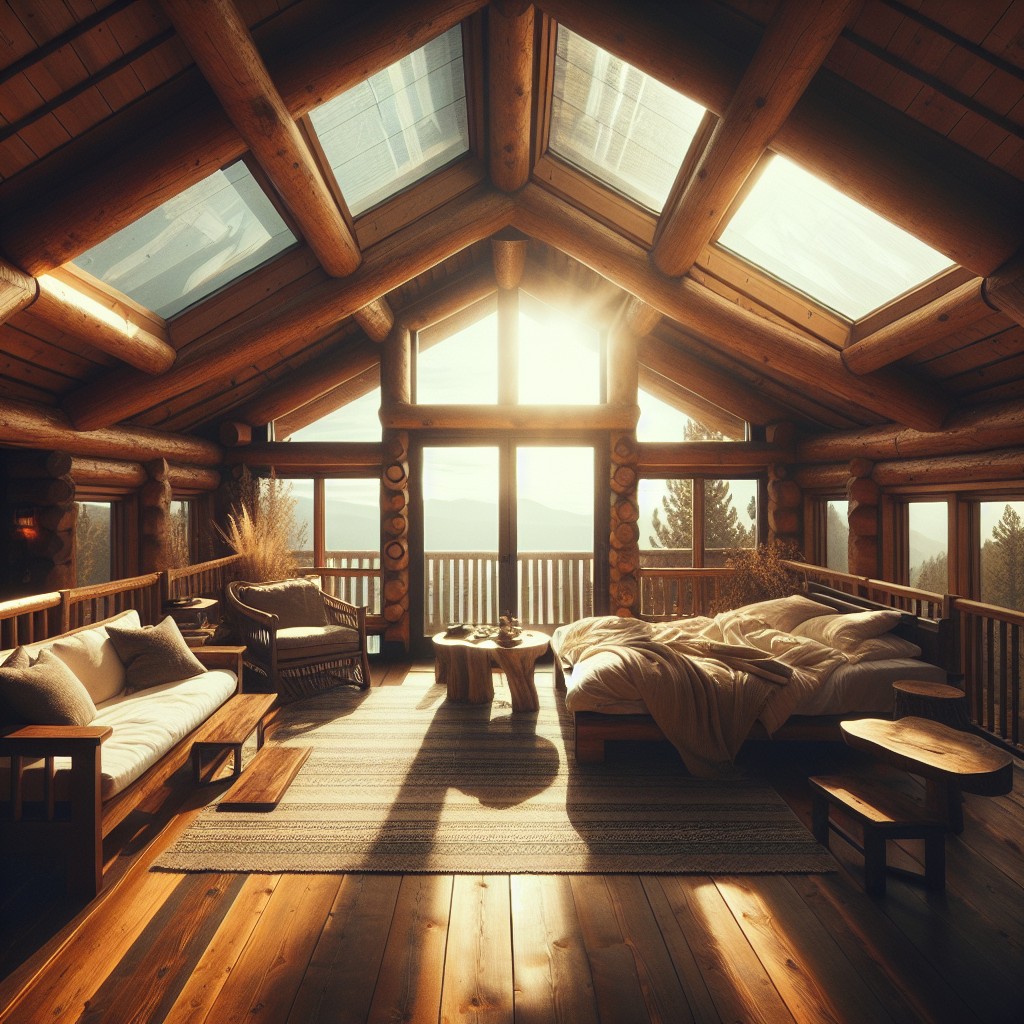
Maximizing natural light can transform a cabin loft from a dark and cramped space to an open, airy retreat. Skylights are the perfect solution to achieve this effect. Consider a few key points when integrating skylights into your cabin loft:
- Orientation and Placement: Position skylights on the roof’s slope where they can capture the maximum amount of sunlight throughout the day. South-facing installations usually garner the most light.
- Size Matters: Opt for larger skylights in spaces where you want more light and warmth. In contrast, smaller skylights can provide adequate light without overheating the space.
- Ventilation Features: Some skylights come with built-in vents that can be opened to allow fresh air to circulate, enhancing the loft’s ventilation and reducing reliance on air conditioning.
- Energy Efficiency: Look for energy-efficient models with glazing or special coatings that minimize heat loss in winter and reduce heat gain in summer. This helps maintain a comfortable environment year-round.
- Style Variations: Choose from a range of styles, from fixed skylights for uninterrupted light to operable ones for added ventilation, or tubular skylights for a more discreet lighting option.
Incorporating these elements ensures your cabin loft benefits from balanced, natural light that enhances both the functionality and aesthetic of the space.
The Role of Art Pieces in Cabin Loft Design

Incorporating art into your cabin loft can harmonize the space with your personal style and bring a sense of refinement. Consider these points to effectively utilize art pieces:
- Scale and Placement: Choose artwork that complements the size of your loft walls. A single large piece can serve as a focal point, while a gallery wall of smaller pieces can create a curated feel. Position art at eye level to maximize impact.
- Cohesion with Decor: Select art that resonates with the existing color palette and design elements of your loft. Whether it’s a rustic landscape painting or a modern sculpture, the art should enhance the overall aesthetic.
- Lighting Considerations: Art can be subdued if improperly lit. Integrate track lighting or picture lights to highlight your pieces and add a warm ambiance to the loft.
- Reflecting the Surroundings: In a cabin setting, artwork that reflects the natural world can create a seamless integration with the environment outside, such as framed nature photography or botanical prints.
- Rotating Displays: Keep the loft feeling fresh by rotating artwork with the seasons or as your tastes evolve. This dynamic approach keeps the space feeling alive and personal.
Loft Office Ideas for Remote Workers
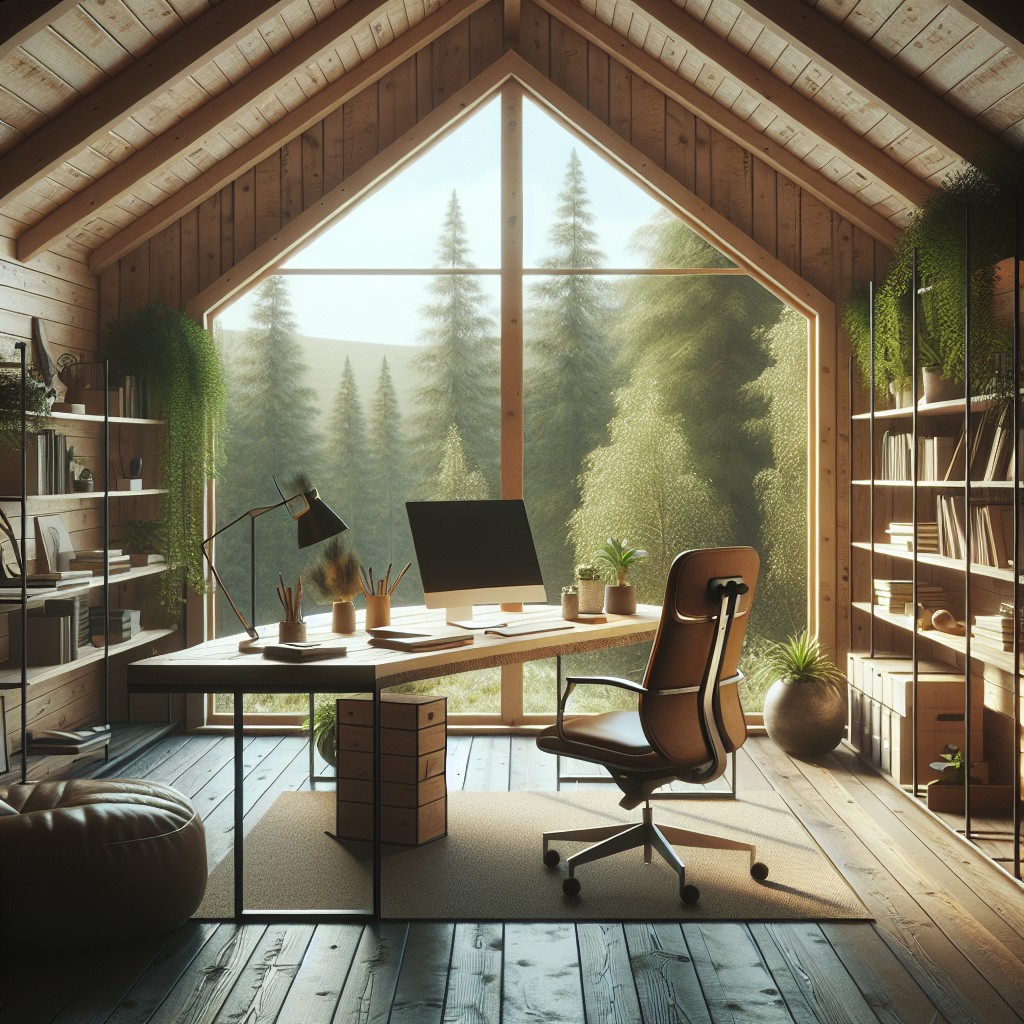
Transforming a portion of your cabin loft into a dedicated workspace can boost productivity and provide a serene environment for remote work. Here are some ways to create an effective loft office:
- Natural Lighting: Position the desk near the loft’s window to take advantage of natural light, reducing eye strain and boosting mood throughout the workday.
- Ergonomic Furniture: Invest in a comfortable, adjustable chair and desk to maintain proper posture and comfort during long working hours.
- Internet Connectivity: Ensure your loft has a strong Wi-Fi signal or consider a wired connection to avoid interruptions during remote meetings or work tasks.
- Storage Solutions: Use wall-mounted shelves and built-in desks with drawers to keep office supplies organized without taking up valuable floor space.
- Soundproofing: Add rugs, fabric wall panels, or a bookshelf filled with books to the loft to help absorb sound, providing a quieter work environment.
- Personalized Decor: Infuse the space with plants, art, or photographs to personalize the space and inspire creativity.
Effective Layout for A Cabin Loft Bedroom
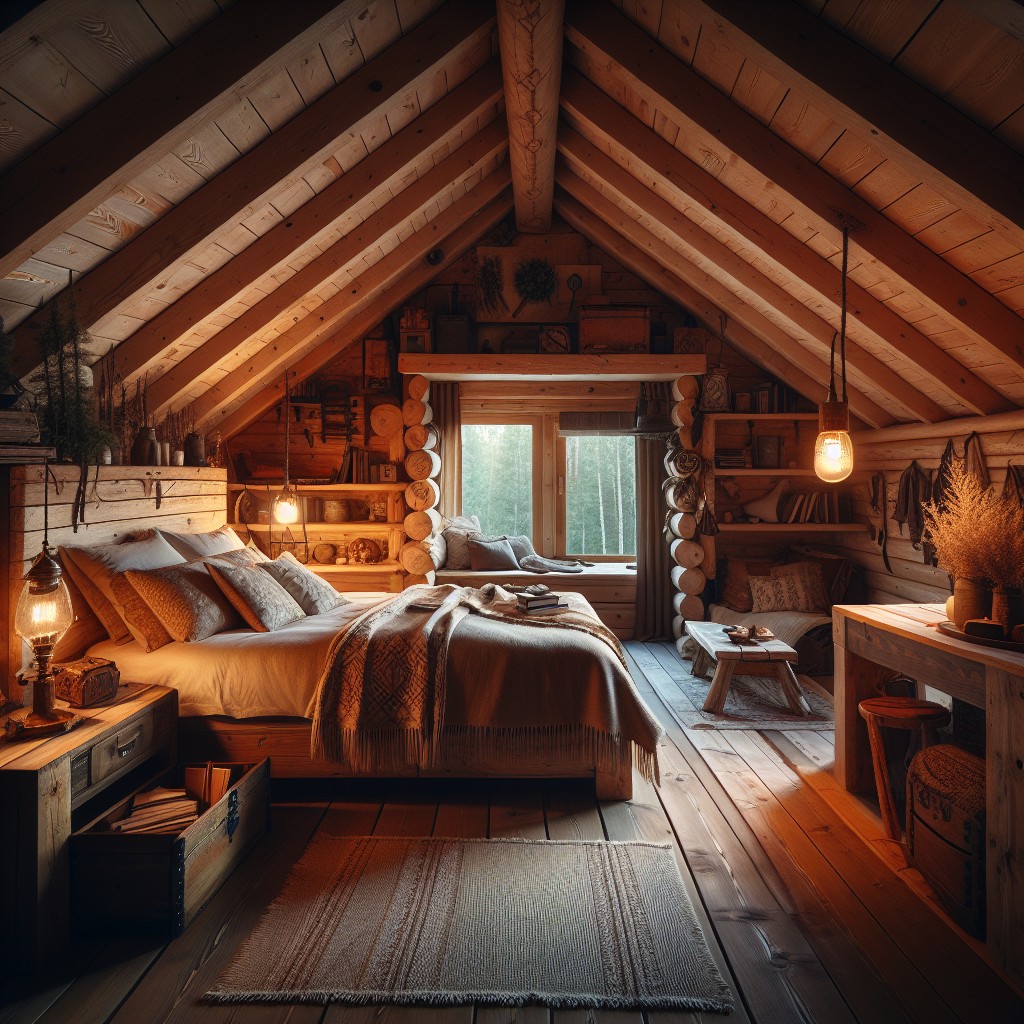
Maximize the limited space of your cabin loft bedroom by carefully considering the placement of the bed. A corner location frees up the room’s center, creating an illusion of more square footage.
Choose low-profile, multifunctional furniture that doesn’t overwhelm the space, doubling as storage, for instance. Soft, warm lighting placed strategically at bedside or anchored from the ceiling brings a cozy ambiance without cluttering surfaces.
Mirrors strategically placed can visually expand the room and reflect light. Opt for built-in shelving or wall-mounted nightstands to preserve floor space.
Keep the color scheme light and airy, with accent hues to add depth and character without visually shrinking the area. Lastly, ensure a clear path for movement and an unobstructed view to the outdoors if windows are present, integrating the natural beauty of your surroundings.
Turning Cabin Loft Into Game Room

Transform your cabin loft into an entertainment hub with a few creative tweaks:
- Prioritize Comfort: Equip the space with plush seating and add bean bags or floor cushions for casual gaming sessions.
- Soundproofing Strategies: Install sound-absorbing panels or thick carpets to keep noise levels contained and avoid disturbing those below.
- Lighting Considerations: Opt for adjustable lighting fixtures that can be dimmed or brightened depending on the mood and type of games being played.
- Tech Setup: Ensure you have the appropriate electrical outlets and wiring for gaming consoles, speakers, and other tech needs.
- Versatile Furniture: Incorporate multi-functional furniture like ottomans with storage or a fold-out couch to accommodate overnight guests.
- Gaming Storage: Designate specific areas for game storage using shelves or custom cabinets to keep games and accessories organized and easily accessible.
- Personal Touch: Add posters, memorabilia, or collectibles to personalize the space and reflect your favorite gaming titles or hobbies.
Questions to Ask Before Building a Cabin Loft

Consider the purpose of your cabin loft; will it serve as additional sleeping space, a storage area, or a dedicated hobby zone? Each function may influence the design and construction.
Evaluate the load capacity of your existing cabin structure to ensure it can support the weight of a loft addition. Consulting with an engineer or experienced contractor is advisable.
Assess the height of your cabin’s ceiling. A loft typically requires at least a 7-foot clearance both above and below to maintain practical headroom and usability.
Examine local building codes and regulations. Secure necessary permits to avoid legal complications and ensure the safety of your loft structure.
Investigate insulation and ventilation needs. A loft can drastically alter the airflow and temperature dynamics of a cabin.
Plan for access. Determine the type and placement of stairs or ladders that will harmonize with your cabin’s layout and intended use of the loft.
Consider lighting. Will natural light suffice, or will you need to integrate electrical solutions? Positioning and window placement can greatly affect the ambiance and functionality of the loft space.
Assess the potential for expansion. If you foresee future enhancements or increased occupancy, design your loft with adaptability in mind.
Ideas Elsewhere
- https://log-cabin-connection.com/cabin-loft.html
- https://www.small-cabin.com/forum/2_8235_0.html
- https://www.thecabindiary.com/loft-cabin/
- https://www.houseplans.com/blog/small-cabin-house-plans-with-loft-and-porch
- https://oakloghome.com/design-perfect-loft-log-cabin/
Related reading:
Table of Contents
